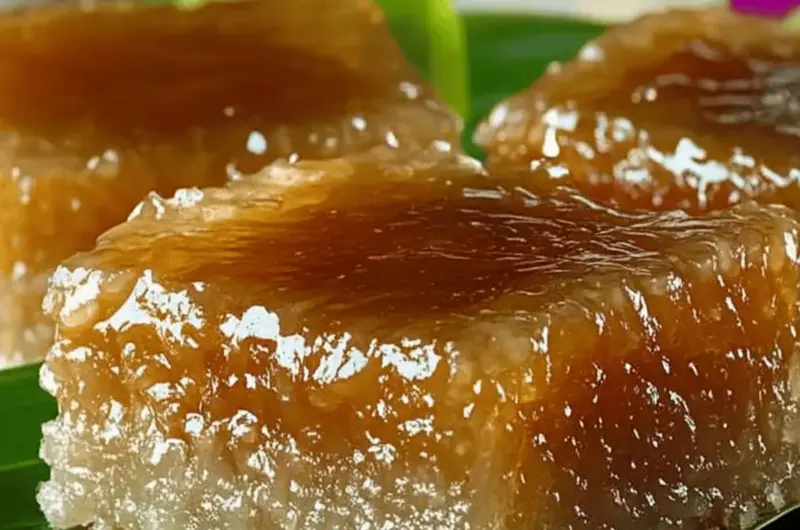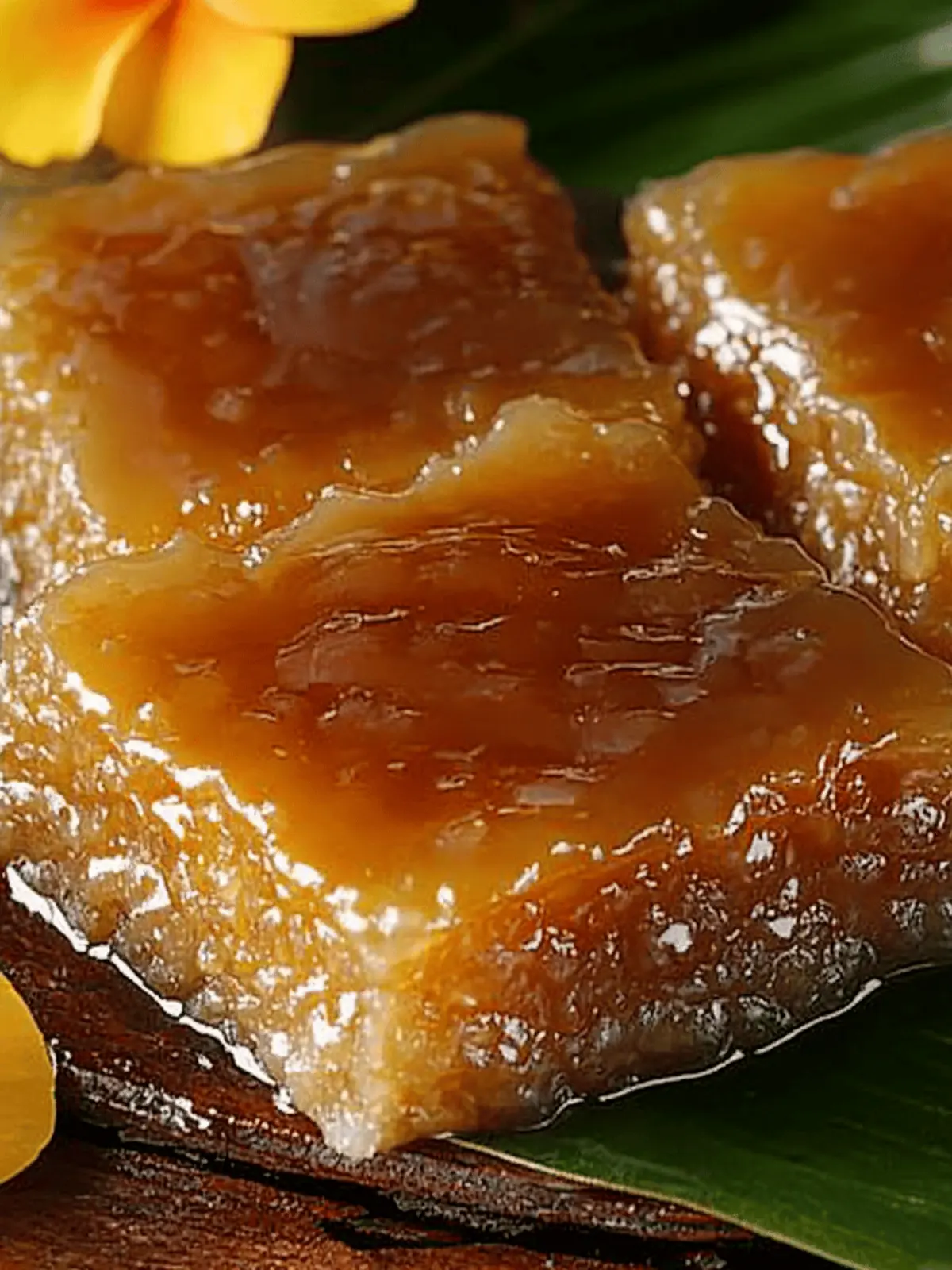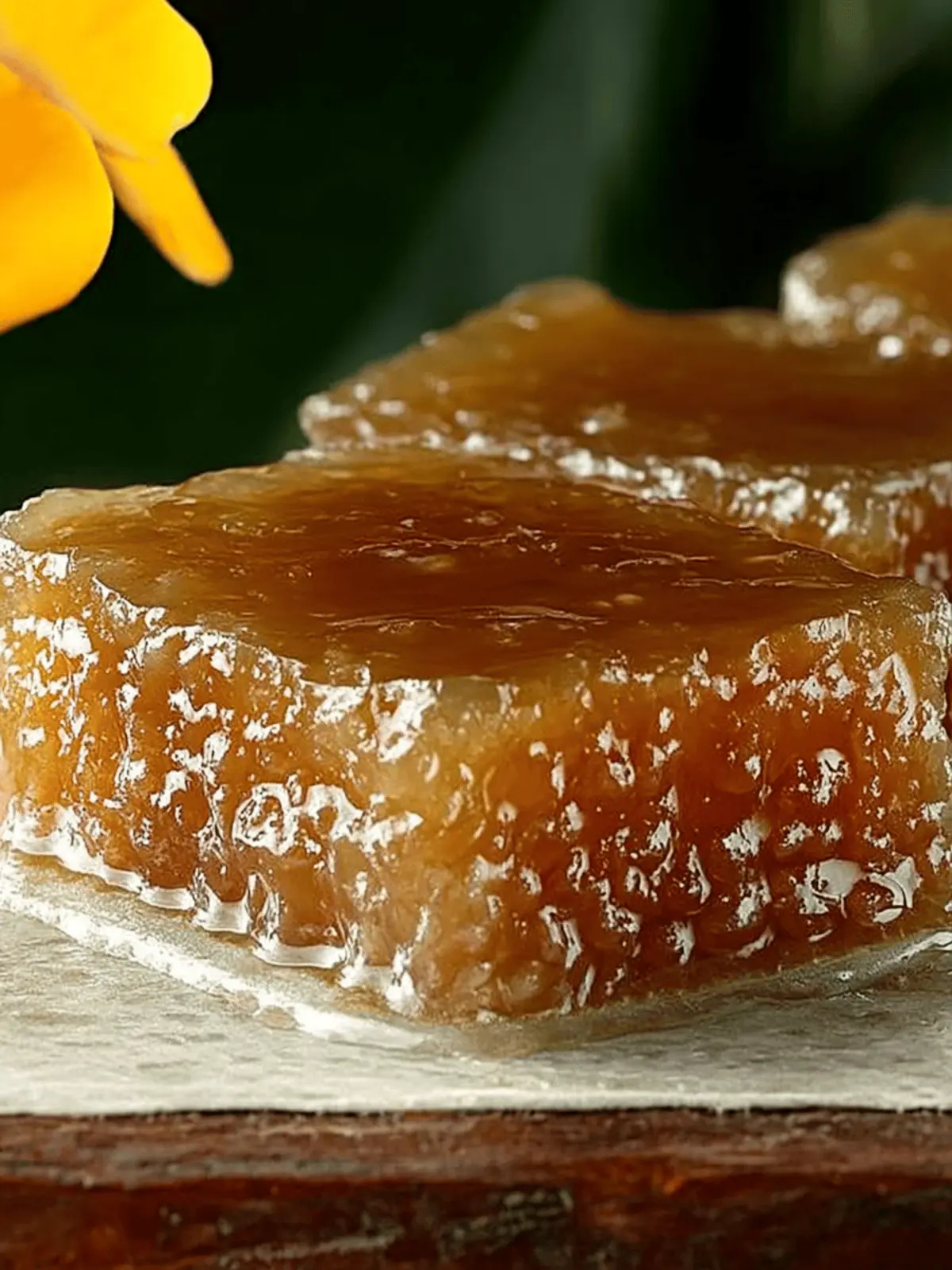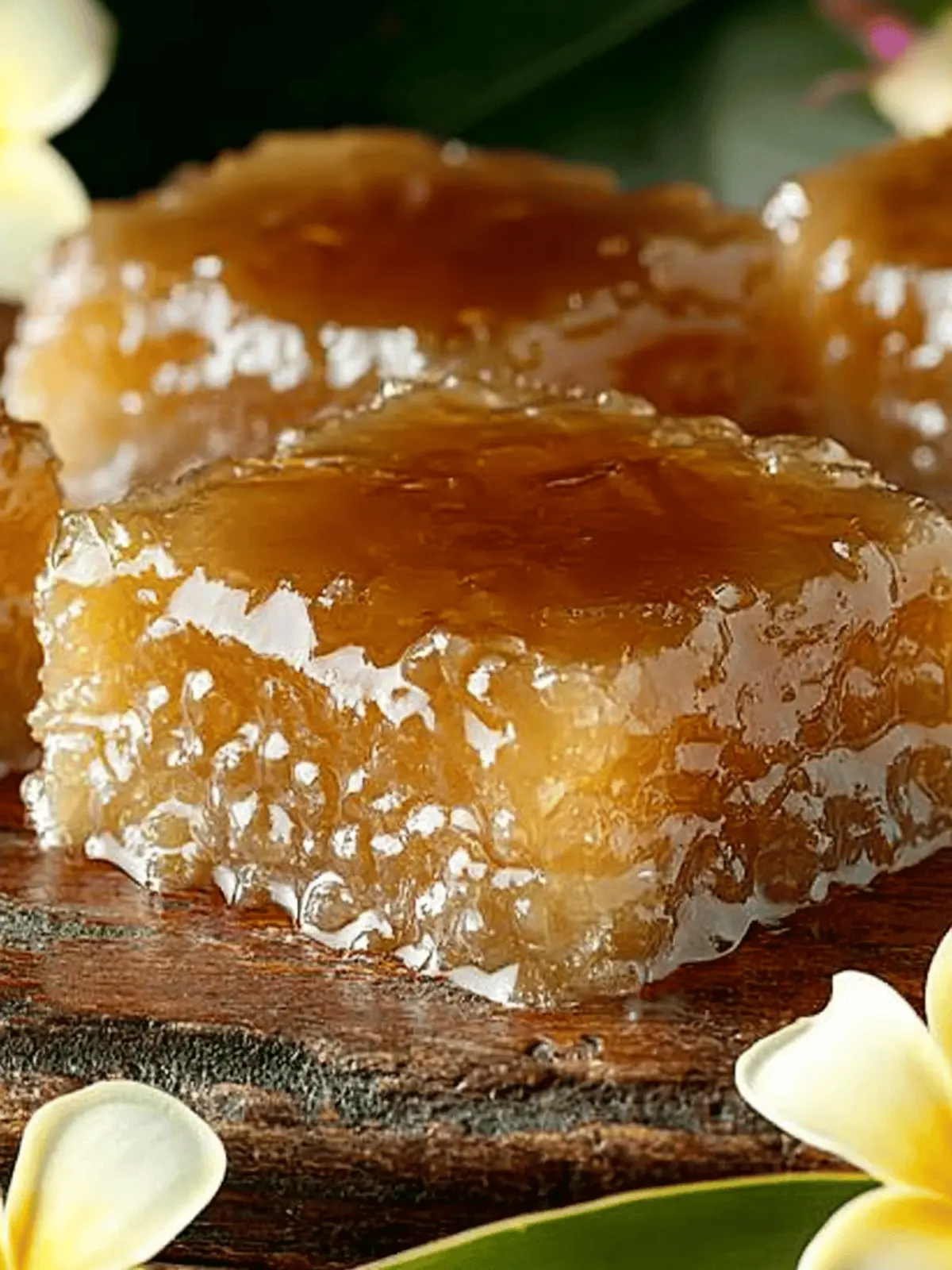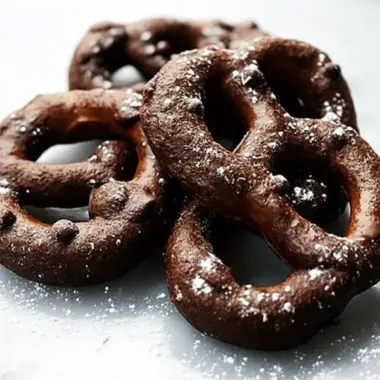There’s something special about the vibrant flavors that fill my kitchen when I prepare Biko, the classic Filipino sticky rice cake. The rich aroma of coconut milk and the sweet notes of caramelized brown sugar transport me back to joyous family gatherings, where laughter and love are shared over this beloved dessert. Each bite of Biko offers a delightful chewiness that melds perfectly with its creamy topping, creating a comforting treat that feels like a warm embrace.
The beauty of this dish lies in its simplicity and versatility. Whether served warm as a comforting dessert after a family meal or as a delightful afternoon snack, Biko is always the star of the table. Plus, its gluten-free nature makes it accessible for everyone to enjoy. So, when you’re ready to bring a taste of the Philippines into your home, gather your ingredients and let’s dive into this nostalgic recipe that promises to deliver comfort in every mouthful.
Why is Biko the ultimate comfort dessert?
Nostalgic flavors: Each bite of Biko evokes warm memories of family gatherings and celebrations.
Simple preparation: The recipe requires minimal ingredients and straightforward steps, making it easy for anyone to recreate this classic treat at home.
Gluten-free delight: Perfect for various dietary preferences, this dessert allows everyone to indulge without worry.
Versatile serving options: Serve it warm, at room temperature, or even chilled; it fits every occasion beautifully.
Crowd-pleaser: The rich, creamy goodness topped with caramel makes Biko a guaranteed hit at any gathering—it’s the kind of dessert that draws people in and keeps them coming back for more!
Biko Ingredients
• Discover the essential components for making Biko.
For the Rice Base
- Glutinous Rice – The heart of this dessert; essential for achieving that delightful sticky texture.
- Water – Necessary for cooking the rice; use just enough for optimal texture.
For the Coconut Mixture
- Coconut Milk – Adds creamy richness; feel free to use coconut cream for a thicker consistency.
- Brown Sugar – Sweetness that caramelizes beautifully; coconut sugar is a perfect substitute for a natural alternative.
- Salt – A pinch is crucial; it balances the sweetness beautifully.
Optional Topping
- Additional Coconut Milk – For making caramel topping; simmer until thickened for an extra layer of decadence.
- Extra Brown Sugar – To enhance the caramel topping; keep an eye on it while cooking to avoid burning.
With these ingredients, you’re all set to create a lovely batch of Biko that captures the warmth and flavor of Filipino comfort food!
How to Make Biko
-
Rinse the glutinous rice under cold water until the water runs clear; this ensures you remove excess starch. Soak the rice for several hours or preferably overnight to achieve the perfect chewiness.
-
Drain the soaked rice and steam it until fully cooked and sticky, about 30 minutes. The texture should be soft yet firm, so set it aside to cool slightly.
-
Combine coconut milk, brown sugar, and a pinch of salt in a saucepan. Cook over medium heat, stirring gently until the sugar dissolves completely and the mixture is smooth.
-
Stir the cooked rice into the coconut mixture, ensuring it’s evenly coated. Cook over low heat for an additional 5-10 minutes until the rice absorbs the flavors and feels sticky.
-
Spread the mixture into a greased baking dish, smoothing out the top for even cutting. Allow it to cool to room temperature before slicing into squares.
-
Optional: For an indulgent caramel topping, simmer additional coconut milk and sugar in a small saucepan until it thickens, then pour over the cooled squares before serving.
Optional: Garnish with toasted coconut flakes for extra texture and flavor.
Exact quantities are listed in the recipe card below.
Expert Tips for Perfect Biko
- Soak Well: Ensure the glutinous rice is soaked for at least 4 hours. This crucial step guarantees optimal stickiness in your Biko.
- Keep Stirring: Stir continuously while cooking the mixture to avoid sticking and burning. It ensures a smooth, creamy texture throughout.
- Monitor Heat: When making the caramel topping, keep the heat low and watch closely to prevent burning. A few moments can make all the difference!
- Use Fresh Ingredients: Always use fresh coconut milk and quality brown sugar for the best flavor. Freshness enhances the overall taste of your Biko.
- Cool Before Cutting: Let the Biko cool completely before slicing it into squares to maintain clean edges and prevent crumbling.
Biko Variations & Substitutions
Feel free to put your own spin on this delightful recipe, and discover unique twists that elevate your Biko experience!
- Fruit Toppings: Add fresh mango or slices of jackfruit for a delightful tropical flavor that complements the sweetness.
- Coconut Flakes: Mix in sweetened grated coconut into the rice for an extra chewy texture and a burst of coconut flavor.
- Nutty Twist: Stir in crushed nuts, such as toasted peanuts or almonds, for a lovely crunch and nutty taste.
- Condensed Milk Drizzle: Enhance the sweetness by drizzling a bit of sweetened condensed milk over the top before serving.
- Choco-Matcha Blend: Experiment by adding a layer of matcha or cocoa powder in between the rice and coconut mixture for an intriguing flavor contrast.
- Dairy-Free Option: Swap coconut milk for almond milk or oat milk to suit your dietary preferences while still keeping it delicious.
- Spicy Flavor: For a unique kick, add a hint of cinnamon or a pinch of cayenne pepper to the coconut mixture, which can create a delightful flavor fusion.
- Chocolate Drizzle: Finish your Biko with a drizzle of melted dark chocolate for an indulgent twist that chocolate lovers will adore.
What to Serve with Biko?
There’s nothing quite like pairing this sweet delight with complementary tastes to create a well-rounded meal experience.
-
Fresh Mango Slices: The natural sweetness and juiciness of ripe mangoes refresh the palate, balancing the rich, sticky texture of Biko beautifully.
-
Coconut Flan: With its creamy consistency and caramel notes, this dessert harmonizes with Biko’s flavors, making for a delightful duo on any dessert table.
-
Tropical Fruit Salad: A mix of pineapple, papaya, and banana adds a zesty contrast to the sweetness of Biko, making each bite exciting and vibrant.
-
Sweetened Condensed Milk: A drizzle of this creamy sweetness enhances Biko’s flavor while adding a delightful creaminess that elevates the entire dessert experience.
-
Iced Barako Coffee: The bold flavors of this Filipino coffee provide a rich and aromatic counterpoint to the sweetness, creating a perfect balance for your taste buds.
-
Turon (Banana Lumpia): Crunchy and caramelized, these sweet banana spring rolls add a delightful texture contrast that complements the chewy Biko in a fun way.
Pairing diverse textures and flavors with Biko not only enriches your dining experience but also creates memorable moments to savor.
Make Ahead Options
Biko is an ideal dessert for meal prep, as many components can be prepped in advance, saving you time on busy days. You can soak the glutinous rice up to 24 hours ahead of time, ensuring it’s perfectly tender when you’re ready to cook. Additionally, the coconut mixture can be combined and stored in the refrigerator for up to 3 days prior; just give it a quick stir before mixing in the cooked rice. To maintain the quality of your Biko, store it in an airtight container. When it’s time to serve, simply follow the final steps, smoothing the mixture into a greased dish and, if you desire, adding the caramel topping before enjoying this delightful treat that’s just as delicious when made ahead!
How to Store and Freeze Biko
Room Temperature: Keep Biko in an airtight container at room temperature for up to 2 days. Ensure it’s well-covered to maintain its soft texture.
Fridge: For longer storage, refrigerate Biko in a sealed container for up to a week. This helps to preserve its flavor and freshness.
Freezer: Biko can be frozen for up to 2 months. Wrap individual squares in plastic wrap and place them in a freezer-safe container for best results.
Reheating: When ready to enjoy, simply thaw in the fridge overnight and reheat gently in the microwave or steam until warmed through.
Biko (Filipino Sticky Rice Cake) Recipe FAQs
What type of glutinous rice should I use for Biko?
I recommend using Thai sticky rice, as it provides the perfect chewiness that’s essential for this dessert. Ensure you rinse it thoroughly under cold water until the water runs clear to remove excess starch, which helps in achieving the ideal texture.
How do I store leftovers of Biko?
You can store leftovers in an airtight container at room temperature for about 2 days. If you want to keep it fresh for a longer period, refrigerate it for up to a week. Make sure it’s well-covered to maintain its soft texture, and you can reheat it gently in the microwave before serving!
Can I freeze Biko? If so, how?
Absolutely! You can freeze Biko for up to 2 months. I suggest wrapping individual squares in plastic wrap and placing them in a freezer-safe container. This way, you can easily thaw out just what you need without worrying about wasting any. When ready to enjoy, thaw it overnight in the fridge and warm it up gently in the microwave or steam it.
What should I do if my Biko topping burns while cooking?
If the caramel topping burns, don’t panic! Remove it from heat immediately to stop further cooking. If it’s slightly burnt, you might need to start over to achieve that rich, sweet flavor without the bitterness. Key steps include stirring frequently and keeping the heat low to give you the best caramel without burning.
Is Biko suitable for people with dietary restrictions?
Yes, Biko is naturally gluten-free, making it an excellent dessert option for those with gluten sensitivities. If you’re accommodating anyone with a coconut allergy, you can try substituting the coconut milk with almond milk, though it will change the flavor markedly. Always check individual ingredients for possible allergens as well!
How long should I soak the glutinous rice before cooking?
Soak the glutinous rice for at least 4 hours; however, soaking overnight is ideal! This soaking process helps achieve that signature sticky texture that Biko is known for. After soaking, remember to drain and steam the rice properly for the best results.
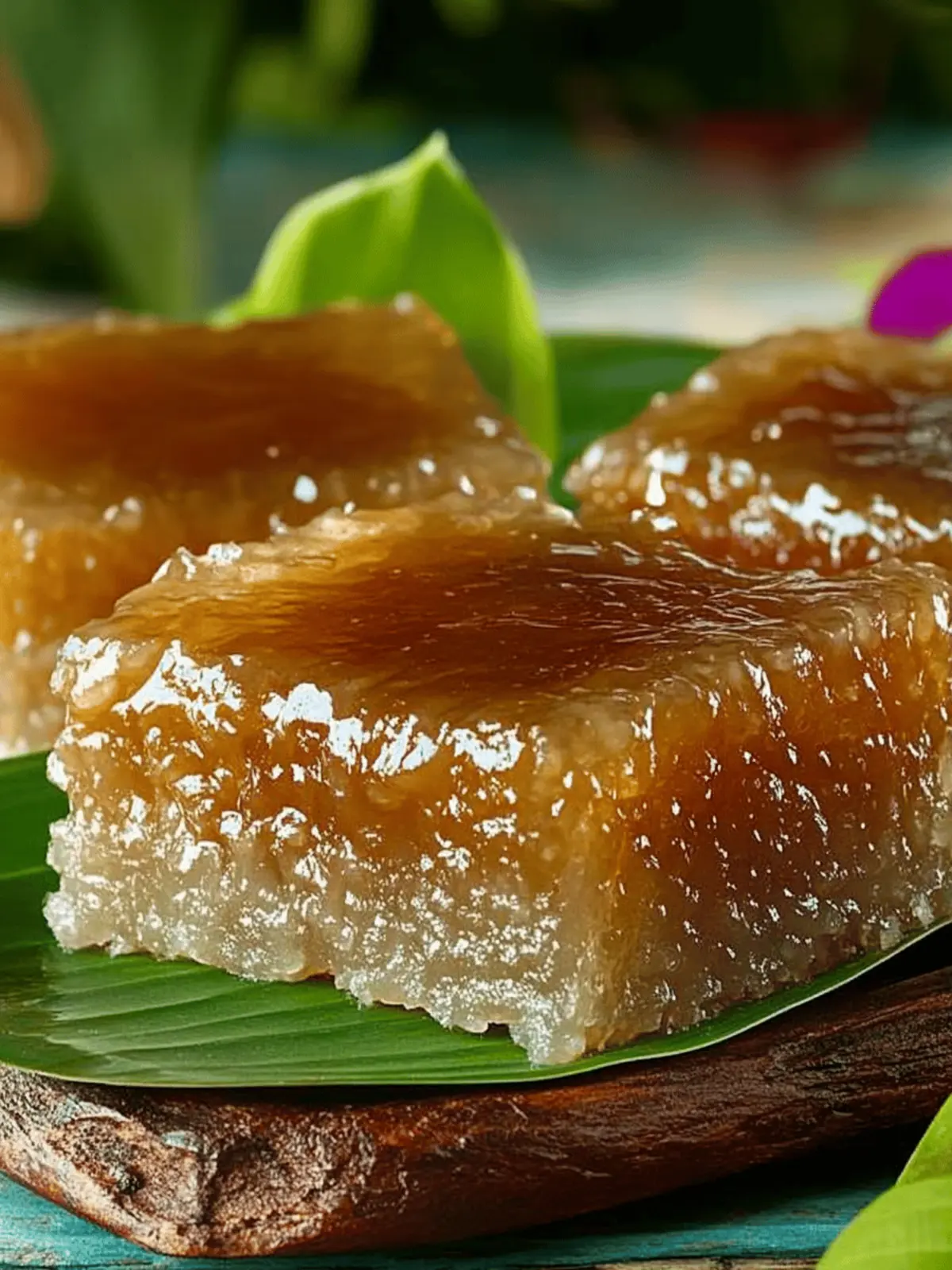
Sweet Biko Delight: Your Guide to Filipino Sticky Rice Cake
Ingredients
Equipment
Method
- Rinse the glutinous rice under cold water until the water runs clear; soak the rice for several hours or overnight.
- Drain the soaked rice and steam it until fully cooked and sticky, about 30 minutes. Set aside to cool.
- Combine coconut milk, brown sugar, and salt in a saucepan over medium heat, stirring gently until the sugar dissolves.
- Stir the cooked rice into the coconut mixture, cooking over low heat for 5-10 minutes until sticky.
- Spread the mixture into a greased baking dish, smoothing out the top. Allow to cool before slicing.
- For an optional caramel topping, simmer additional coconut milk and sugar until thickened, then pour over cooled squares.

